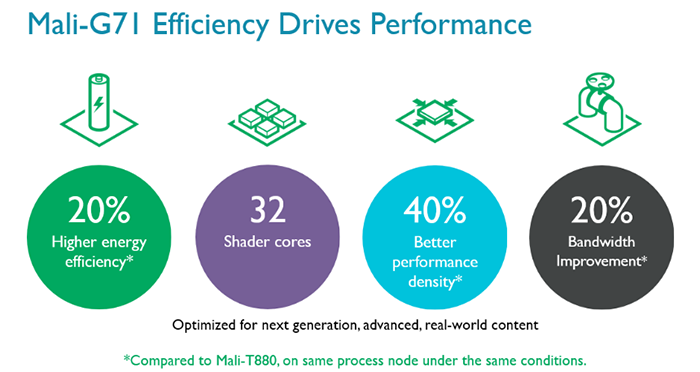High-End Gaming
In 2017, the market for mobile gaming is expected to hit over US$40 billion, up $10 billion from 2016.* Sustaining this rapid growth with emerging new mobile devices is no mean feat. Our gaming demos from just a couple of years ago had half the number of vertices as the ones we’re producing today and this all adds up in terms of power and efficiency requirements. If applications continue to advance at this rate the ability to scale to 32 cores could rapidly become a basic necessity for premium mobile devices. On top of this, Mali-G71 delivers 20% higher energy efficiency compared to Mali-T880 under similar conditions – translating to higher sustained device performance in thermally limited premium devices.
Vulkan and OpenCL2.0
API advancements define how developers interact with the underlying hardware. As a GPU and CPU company, ARM needs to meet developer needs so that end users get the best possible device experience. In recent years there’s been a move towards giving developers lower-level access to the hardware, in Khronos. This trend lead to the emergence of the new Vulkan 1.0 API. In a similar vein, OpenCL 2.0 was developed to make heterogeneous compute more developer friendly and there are high hopes that we will see some radical new use cases popping up once OpenCL2.0 enabled devices are shipping in the market. Mali-G71 is not only designed to support Vulkan 1.0 and OpenCL 2.0 Full Profile – it even has support for fine-grained buffers and shared virtual memory, enabled through full hardware coherency support. Again, this is primarily to ease software development effort, leading to better end user experiences.
Virtual Reality (VR)
VR is what everyone’s talking about in the graphics industry at the moment: what it takes, what it needs and how to provide the very best VR experience to the user. The Mali-G71 GPU was built with just this sort of challenge in mind. The extensive performance requirements of VR mean that GPUs for high-end devices have to be more energy efficient today. Other components of the mobile, such as cameras and screen resolutions, are advancing and performing at higher rates and therefore all contributing to maxing out the thermal budget of the device. This puts greater pressure on the GPU to reduce power usage wherever possible.
The Mali family of GPUs has VR optimization features to allow for the best possible mobile VR experience. Front buffer rendering allows you to bypass the usual off screen buffers to render directly to the front buffer, saving time and reducing latency. Mali also supports the ‘multiview’ API extensions that allow the application to submit the draw commands for a frame to the driver once and have the driver instantiate the necessary work for each eye. This greatly reduces the CPU time required in both the application and driver. On Midgard and Bifrost-based Mali GPUs, we further optimize the vertex processing work, running the parts of the vertex shader that do not depend upon the eye once and sharing the results between each eye.
Content Protection
The recently released Mali-DP650 display processor already has the capability to handle 4k content and the Mali-G71 allows this content to be streamed seamlessly to a TV without losing any of the quality. This means that, whilst 4k hasn’t yet taken off on mobile, you don’t need to miss out on any of the benefits when viewing the content on a separate 4k device.
Mali-G71 is achieving the highest possible performance for mobile graphics within the smallest possible power budget and silicon area, allowing our partners to achieve the pinnacle of mobile graphics in the most scalable and customizable way. With Mali-G71-based devices expected to hit the shelves early in 2017, next level mobile gaming and graphics is within your grasp.
*Fortune.com
















